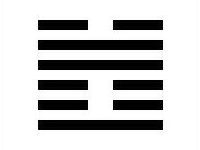
Hexagram 17 - Sui / Following - James Legge Translation

- Above Tui the Joyous, Lake
- Below Chen the Arousing, Thunder
Meaning
Those who create pleasure and satisfaction soon have a following. Sui indicates that under its conditions there will be great progress and success. But it will be advantageous to be firm and correct. There will then be no error.
Meaning Commentary
Sui symbolizes the idea of following. It is said to follow Yu, the symbol of harmony and satisfaction. Where there are these conditions men are sure to follow; nor will they follow those in whom they have no complacency. The hexagram includes the cases where one follows others, and where others follow him; and the auspice of great progress and success is due to this flexibility and applicability of it. But in both cases the following must be guided by a reference to what is proper and correct. See the notes on the Thwan and the Great Symbolism.
<-Prev Next->The Image
Thunder in the middle of the lake: The image of Following. Thus the superior man at nightfall Goes indoors for rest and recuperation.
Image Commentary
In the autumn electricity withdraws into the earth again and rests. Here it is the thunder in the middle of the lake that serves as the image--thunder in its winter rest, not thunder in motion. The idea of following in the sense of adaptation to the demands of the time grows out of this image. Thunder in the middle of the lake indicates times of darkness and rest. Similarly, a superior man, after being tirelessly active all day, allows himself rest and recuperation at night. No situation can become favorable until one is able to adapt to it and does not wear himself out with mistaken resistance.
King Wans explanation
- In Sui we see the strong trigram come and place itself under the weak; we see in the two the attributes of movement and pleasure: this gives the idea of Sui.
- There will be great progress and success; and through firm correctness no error:' all under heaven will be found following at such a time.
- Great indeed are the time and significance indicated in Sui.
Legge Footnotes on King Wans explanation
The trigrams Chen and Tui are distinguished as strong and weak, Chen representing, on king Wan's scheme, the eldest son, and Tui, the youngest daughter. But the strong here may mean the strong line, the lowest in the hexagram. As Wang Zung-Kuan Sung dynasty says: The yang and strong line should not be below a yin and weak line, as we find it here. That is, in Sui the high places himself below the low, and the noble below the mean: esteeming others higher than himself, and giving the idea of following. Then Chen denotes the production or excitement of motion, and Tui denotes pleasure; and the union of these things suggests the same idea.
The Lines
The first NINE, undivided, shows us one changing the object of his pursuit; but if he be firm and correct, there will he good fortune. Going beyond his own gate to find associates, he will achieve merit.
Line 1 is strong, and lord of the lower trigram. The weak lines ought to follow it; but here it is below them, in the lowest place of the figure. This gives rise to the representation of one changing his pursuit. Still through the native vigour indicated by the line being strong, and in its correct place, its subject will be fortunate. Going beyond his gate to find associates indicates his public spirit, and superiority to selfish considerations.
The second SIX, divided, shows us one who cleaves to the little boy, and lets go the man of age and experience.
Line 2 is weak. Its proper correlate is the strong 5; but it prefers to cleave to the line below, instead of waiting to follow 5. Hence the symbolism of the text, the bad omen of which needs not to be mentioned.
The third SIX, divided, shows us one who cleaves to the man of age and experience, and lets go. the little boy. Such following will get what it seeks; but it will be advantageous to adhere to what is firm and correct.
Line 3 is also weak, but it follows the strong line above it and leaves line 1, reversing the course of 2; with a different issue. It is weak, however, and 4 is not its proper correlate; hence the conclusion of the paragraph is equivalent to a caution.
The fourth NINE, undivided, shows us one followed and obtaining adherents. Though he be firm and correct, there will be evil. If he be sincere however in his course, and make that evident, into what error will he fall?
Line 4 is strong, and in the place of a great minister next the ruler in 5. But his having adherents may be injurious to the supreme and sole authority of that ruler, and only a sincere loyalty will save him from. error and misfortune.
The fifth NINE, undivided, shows us the ruler sincere in fostering all that is excellent. There will be good fortune.
Line 5 is strong, and in its correct place, with 2 as its proper correlate; thus producing the auspicious symbolism.
The topmost SIX, divided, shows us that sincerity firmly held and clung to, yea, and bound fast. We see the king with it presenting his offerings on the western mountain.
The issue of the hexagram is seen in line 6 which represents the ideal of following, directed by the most sincere adherence to what is right. This influence not only extends to men, but also to spiritual beings. The western hill is mount Khi, at the foot of which was the original settlement of the house of Kau, in B. C. 1325. The use of the name king here brings us down from Wan into the time of king Wu at least.
